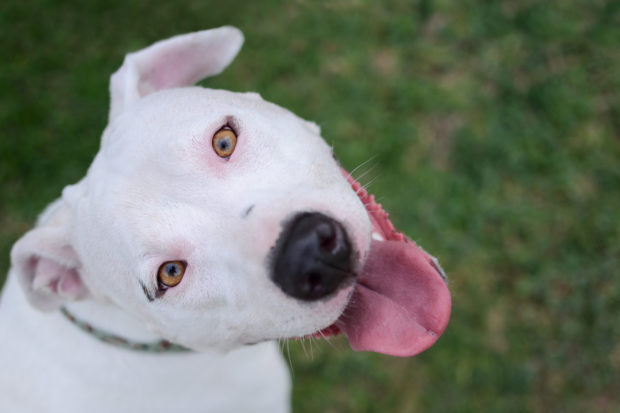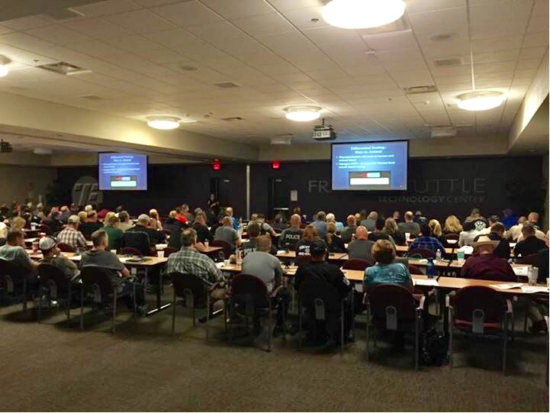
At The HSUS, we are advocates of dogs, and we are allies of the police. That’s why we are working to prevent deadly encounters between the two through our Humane State Program and the HSUS Law Enforcement Training Center. Photo by iStockphoto
Last July, Vickie Malone hosted kids at her home in Wynnewood, Oklahoma, to celebrate her five-year old son’s birthday. Eli and the other kids were about to get ice cream and cake when they heard a shot ring out.
Opie, the boy’s pit bull mix, was gasping for air after a local police officer in the small Oklahoma town shot the dog, presumably because of aggressive behavior. Parents and kids raced outside, and the officer fired two more shots into Opie. A celebratory event turned into a tragic one.
The police offer had been there to serve a warrant, but the subject of the warrant hadn’t lived at the address in years. Eli’s family had done nothing wrong, and the policeman’s visit happened only because of an out-of-date database.
The U.S. Department of Justice estimates that police officers, often acting as first responders in crisis situations, shoot and kill as many as 10,000 dogs a year — that is one dog every hour of every day. It’s a staggering and surprising and distressing number. Though some of these deadly encounters cannot be avoided, training for police officers on how to assess a dog’s body language, possible intentions, and the use of passive, non-lethal methods is not a standard in police academy or in service training.
At The HSUS, we are advocates of dogs, and we are allies of the police, who enforce our animal protection laws and other statutes that keep order in society. We want to solve this problem, and that’s why we are working to prevent these deadly encounters through our Humane State Program and the HSUS Law Enforcement Training Center, which, among so many other purposes, train law enforcement officials on how to safely and effectively deal with canine encounters.
This week, we were in Oklahoma where 550 law enforcement officers received training and resources from HSUS experts on encounters between police and dogs, understanding the process of bonding and forfeiture in cruelty cases, and veterinary forensics. The officers also received resources like control poles and leashes to help them when they encounter dogs on the field.
Last week, we were in Oklahoma where 550 law enforcement officers received training and resources from HSUS experts on encounters between police and dogs, understanding the process of bonding and forfeiture in cruelty cases, and veterinary forensics. Photo by The HSUS
Only a handful of states require police officers to receive training on encounters with dogs, most of which were implemented after large civil, and in some instances, criminal charges were filed against officers and their departments in the deaths of dogs. Dog owners are fighting back and winning these large lawsuits. Under the Fourth Amendment, shooting someone’s dog has been considered by multiple district courts as a “seizure” of property. Recently, in Anne Arundel County, Maryland, a court awarded a man $1.26 million dollars for the death of his beloved Chesapeake Bay retriever who was shot and killed by the police. Training to handle these encounters in non-violent ways is good business for the police and it’s good public relations.
Police officers are put in harrowing situations every day and must make life-and-death decisions in a split second. When dogs are added to these situations, the consequences can often turn deadly due to lack of training and tactical options Providing knowledge, experience, and tactical options to every possible officer is one goal of our multi-faceted Humane State Program.
The National Sheriffs’ Association is working on the issue with The HSUS, and has a training video and other resources on its website to allow officers to handle these circumstances.
Law enforcement officers and the agencies that employ them have an enormous array of responsibilities, and they encounter a dizzying array of circumstances. We know that good training will help them, it will spare animal lives, and it will allow for better enforcement of our animal protection laws. That’s why we’re working so hard on this program, and it’s a win for all parties, including the dogs.
The post Helping the police, and helping dogs in the process appeared first on A Humane Nation.
Enviroshop is maintained by dedicated NetSys Interactive Inc. owners & employees who generously contribute their time to maintenance & editing, web design, custom programming, & website hosting for Enviroshop.

